Legal Enforcement of an Agreement: P vs D - TLAW401 Course Assignment
VerifiedAdded on 2022/11/28
|15
|1008
|83
Homework Assignment
AI Summary
This assignment analyzes the legal enforceability of an agreement between two parties, P and D, based on the principles of contract law. The analysis begins by identifying the key elements of a valid contract: offer and acceptance, consideration, consensus ad idem (mutual consent), intention to create legal obligations, and capacity to contract. The assignment applies these elements to the scenario where P, a songwriter, and D, a music publisher, entered into an agreement. It assesses whether the original agreement is legally enforceable, considering the presence or absence of each essential element. The analysis references relevant legal cases such as Smith v Hughes, Currie v Misa, Carlill v Carbolic Smoke Ball Company, and Merritt v Merritt to support its conclusions. The conclusion is that the original agreement between P and D is legally enforceable because all the essential elements of a valid contract are present.

LEGAL ENFORCEMENT
OF AN AGREEMENT
Topic 5
OF AN AGREEMENT
Topic 5
Paraphrase This Document
Need a fresh take? Get an instant paraphrase of this document with our AI Paraphraser

Whether the original agreement
between P & D is legally
enforceable.
Issue
between P & D is legally
enforceable.
Issue

Rule
Essential Elements of a Valid Contract
Offer and Acceptance
Consideration
Consensus ad idem (Mutual consent)
Intention of creating legal obligation
Capacity to contract
Essential Elements of a Valid Contract
Offer and Acceptance
Consideration
Consensus ad idem (Mutual consent)
Intention of creating legal obligation
Capacity to contract
⊘ This is a preview!⊘
Do you want full access?
Subscribe today to unlock all pages.

Trusted by 1+ million students worldwide
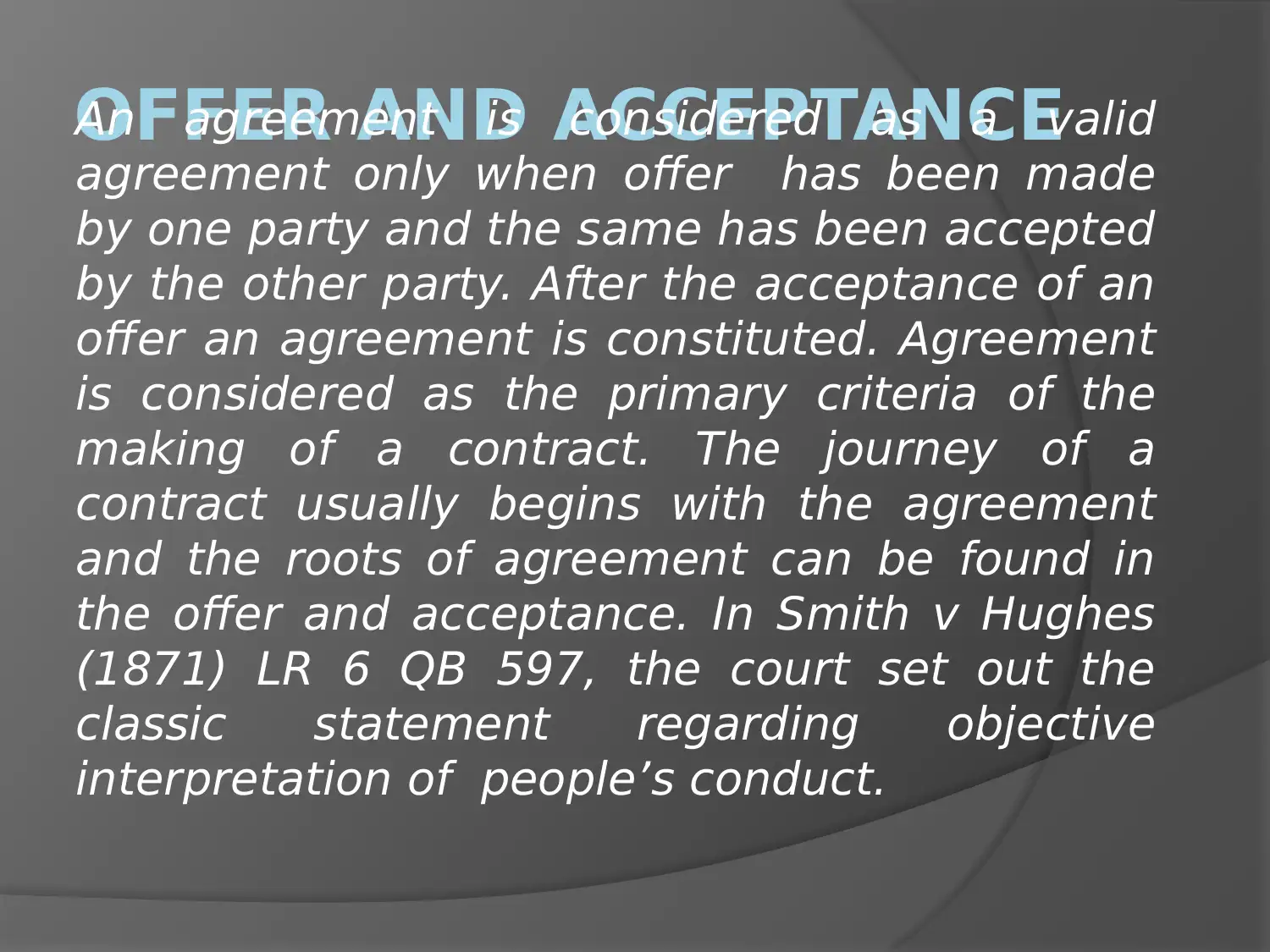
OFFER AND ACCEPTANCEAn agreement is considered as a valid
agreement only when offer has been made
by one party and the same has been accepted
by the other party. After the acceptance of an
offer an agreement is constituted. Agreement
is considered as the primary criteria of the
making of a contract. The journey of a
contract usually begins with the agreement
and the roots of agreement can be found in
the offer and acceptance. In Smith v Hughes
(1871) LR 6 QB 597, the court set out the
classic statement regarding objective
interpretation of people’s conduct.
agreement only when offer has been made
by one party and the same has been accepted
by the other party. After the acceptance of an
offer an agreement is constituted. Agreement
is considered as the primary criteria of the
making of a contract. The journey of a
contract usually begins with the agreement
and the roots of agreement can be found in
the offer and acceptance. In Smith v Hughes
(1871) LR 6 QB 597, the court set out the
classic statement regarding objective
interpretation of people’s conduct.
Paraphrase This Document
Need a fresh take? Get an instant paraphrase of this document with our AI Paraphraser
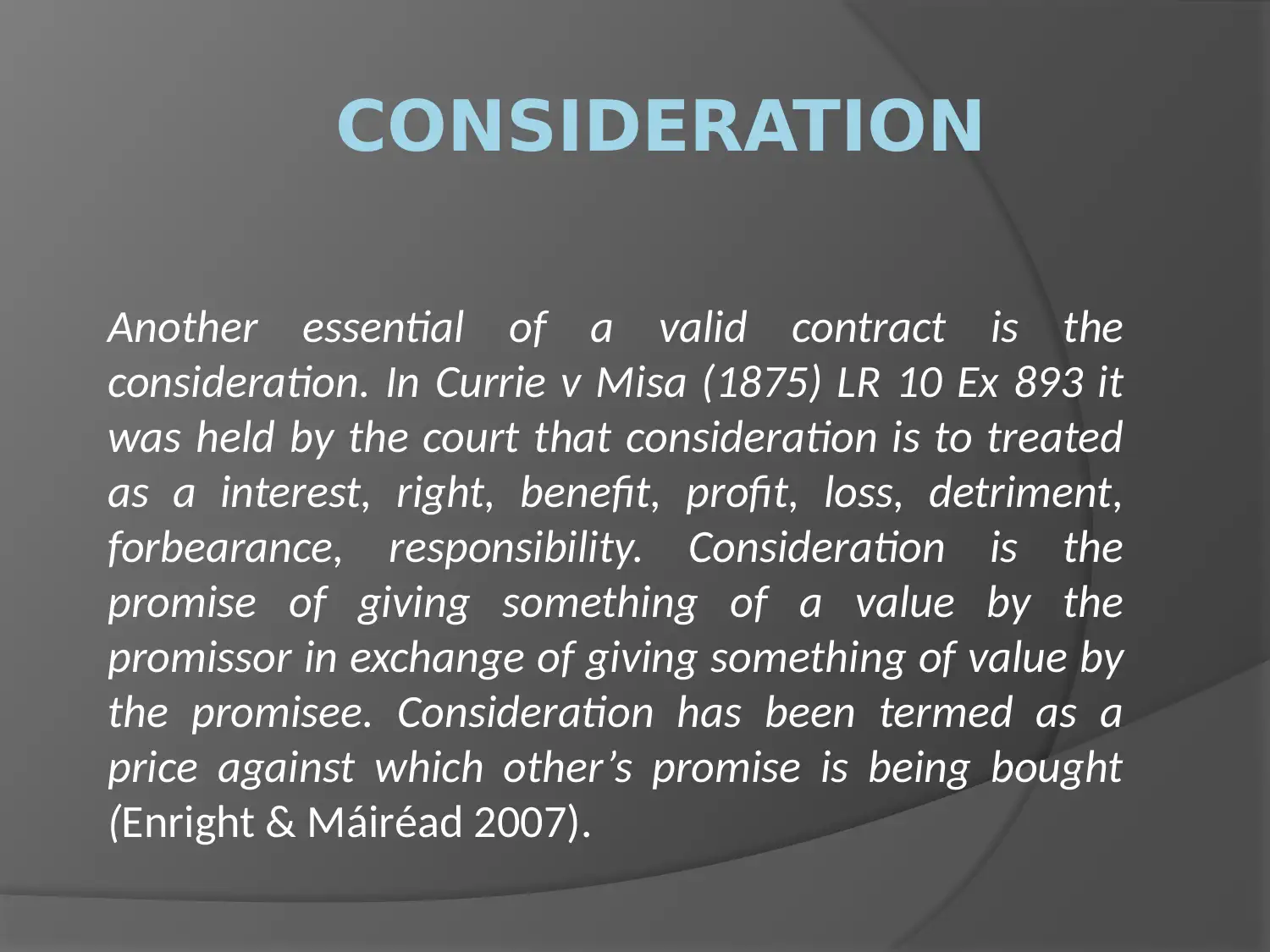
CONSIDERATION
Another essential of a valid contract is the
consideration. In Currie v Misa (1875) LR 10 Ex 893 it
was held by the court that consideration is to treated
as a interest, right, benefit, profit, loss, detriment,
forbearance, responsibility. Consideration is the
promise of giving something of a value by the
promissor in exchange of giving something of value by
the promisee. Consideration has been termed as a
price against which other’s promise is being bought
(Enright & Máiréad 2007).
Another essential of a valid contract is the
consideration. In Currie v Misa (1875) LR 10 Ex 893 it
was held by the court that consideration is to treated
as a interest, right, benefit, profit, loss, detriment,
forbearance, responsibility. Consideration is the
promise of giving something of a value by the
promissor in exchange of giving something of value by
the promisee. Consideration has been termed as a
price against which other’s promise is being bought
(Enright & Máiréad 2007).

CONSENSUS AD IDEM
The third essential element of constituting a valid
contract is the consensus ad idem which is also known as
the party’s mutual consent. The parties of an agreement
needs to agree on the same thing at same time and in a
same sense. In Carlill v Carbolic Smoke Ball Company
[1893] 1 QB 256, it was held by the court that two minds
need to come together in order to constitute consensus,
which is considered necessary in the English law.
The third essential element of constituting a valid
contract is the consensus ad idem which is also known as
the party’s mutual consent. The parties of an agreement
needs to agree on the same thing at same time and in a
same sense. In Carlill v Carbolic Smoke Ball Company
[1893] 1 QB 256, it was held by the court that two minds
need to come together in order to constitute consensus,
which is considered necessary in the English law.
⊘ This is a preview!⊘
Do you want full access?
Subscribe today to unlock all pages.

Trusted by 1+ million students worldwide
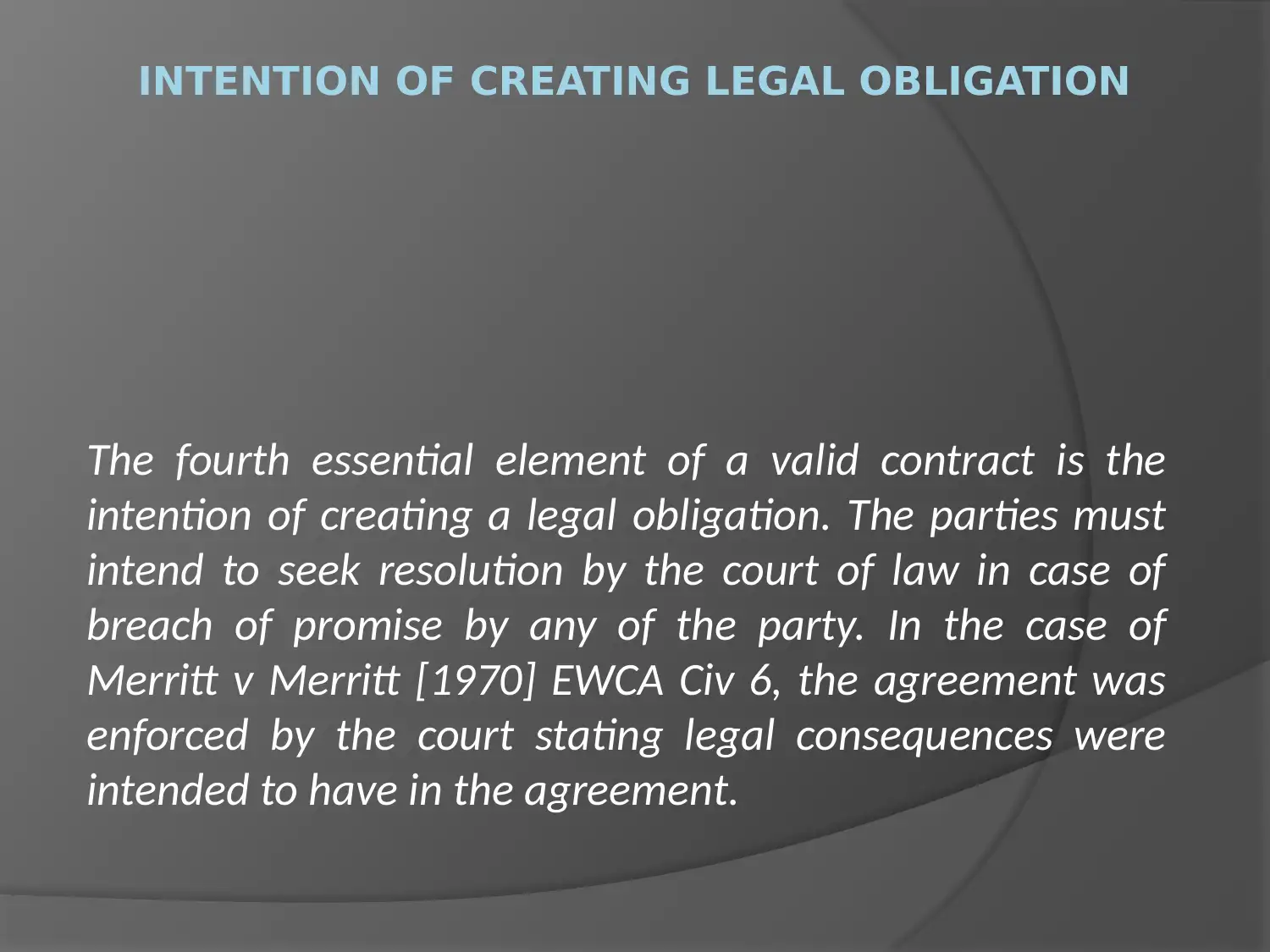
INTENTION OF CREATING LEGAL OBLIGATION
The fourth essential element of a valid contract is the
intention of creating a legal obligation. The parties must
intend to seek resolution by the court of law in case of
breach of promise by any of the party. In the case of
Merritt v Merritt [1970] EWCA Civ 6, the agreement was
enforced by the court stating legal consequences were
intended to have in the agreement.
The fourth essential element of a valid contract is the
intention of creating a legal obligation. The parties must
intend to seek resolution by the court of law in case of
breach of promise by any of the party. In the case of
Merritt v Merritt [1970] EWCA Civ 6, the agreement was
enforced by the court stating legal consequences were
intended to have in the agreement.
Paraphrase This Document
Need a fresh take? Get an instant paraphrase of this document with our AI Paraphraser

CAPACITY TO
CONTRACT
The fifth essential element of a valid contract is the
capacity to contract. For the purpose of entering into a
contract a person must be capable of creating a
relationship of contract. The person needs to be, a
major person means he has attained the age of 18
years; of sound mind and must not be disqualified from
entering into a contract by law.
CONTRACT
The fifth essential element of a valid contract is the
capacity to contract. For the purpose of entering into a
contract a person must be capable of creating a
relationship of contract. The person needs to be, a
major person means he has attained the age of 18
years; of sound mind and must not be disqualified from
entering into a contract by law.
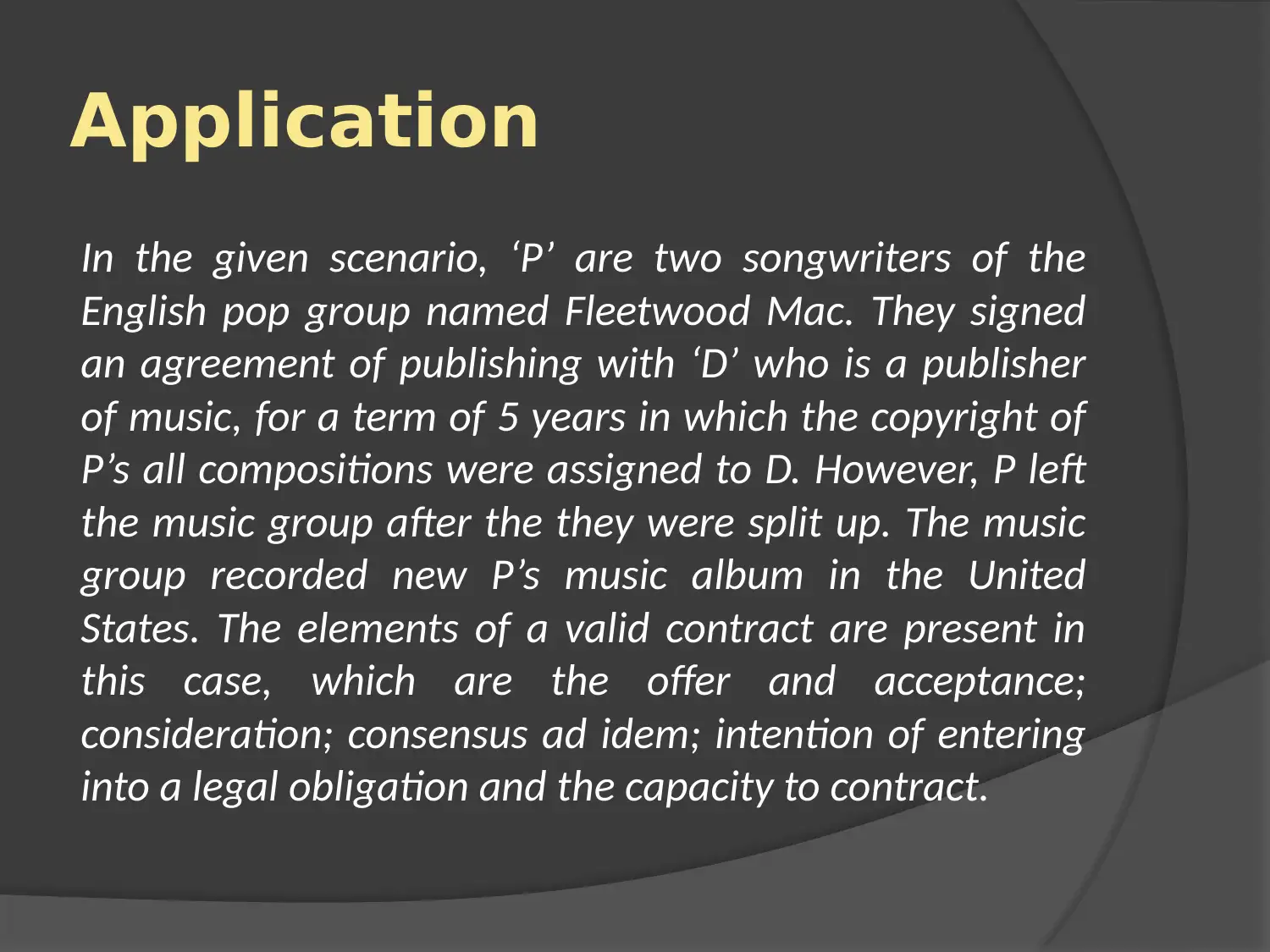
Application
In the given scenario, ‘P’ are two songwriters of the
English pop group named Fleetwood Mac. They signed
an agreement of publishing with ‘D’ who is a publisher
of music, for a term of 5 years in which the copyright of
P’s all compositions were assigned to D. However, P left
the music group after the they were split up. The music
group recorded new P’s music album in the United
States. The elements of a valid contract are present in
this case, which are the offer and acceptance;
consideration; consensus ad idem; intention of entering
into a legal obligation and the capacity to contract.
In the given scenario, ‘P’ are two songwriters of the
English pop group named Fleetwood Mac. They signed
an agreement of publishing with ‘D’ who is a publisher
of music, for a term of 5 years in which the copyright of
P’s all compositions were assigned to D. However, P left
the music group after the they were split up. The music
group recorded new P’s music album in the United
States. The elements of a valid contract are present in
this case, which are the offer and acceptance;
consideration; consensus ad idem; intention of entering
into a legal obligation and the capacity to contract.
⊘ This is a preview!⊘
Do you want full access?
Subscribe today to unlock all pages.

Trusted by 1+ million students worldwide
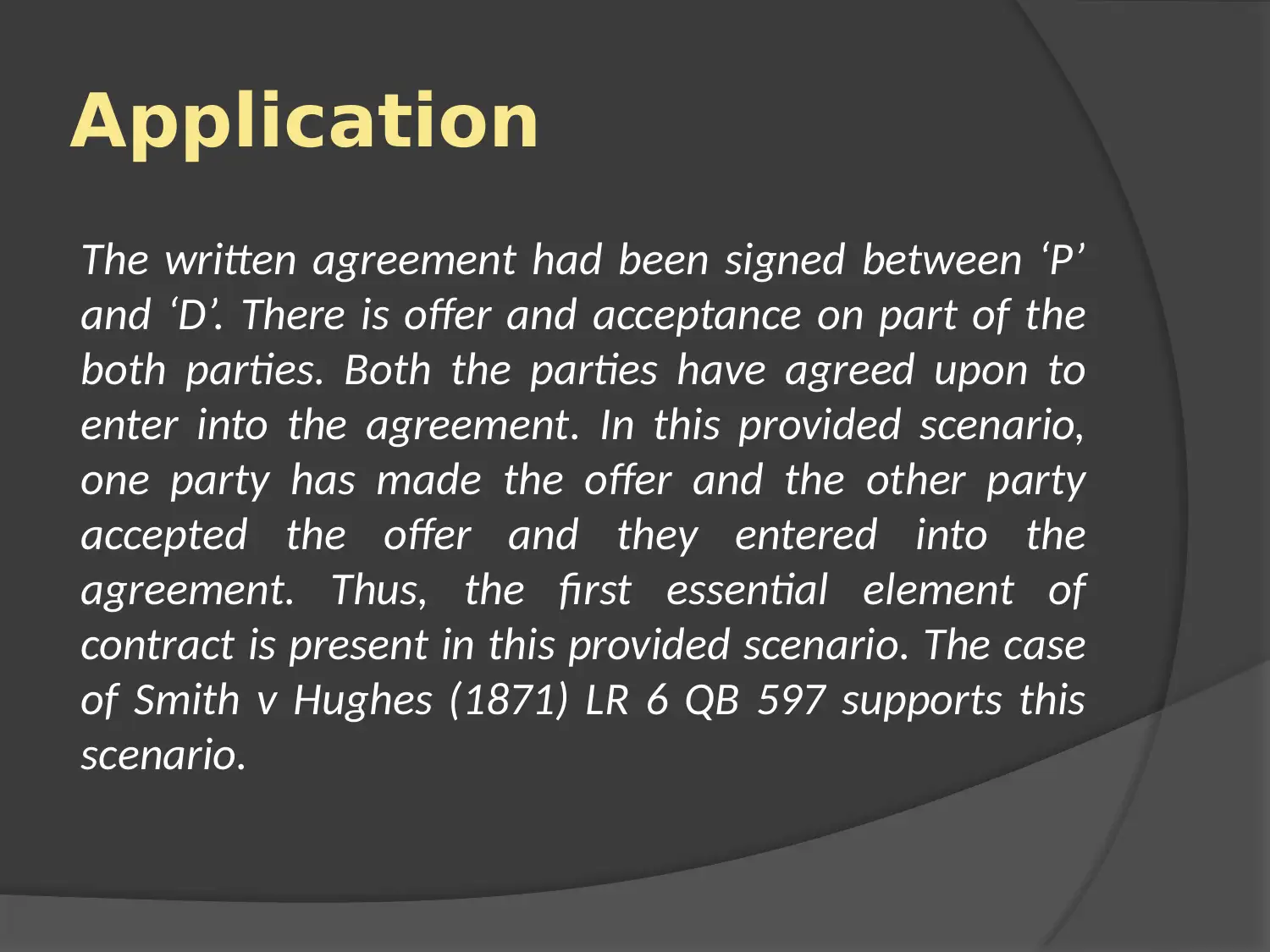
Application
The written agreement had been signed between ‘P’
and ‘D’. There is offer and acceptance on part of the
both parties. Both the parties have agreed upon to
enter into the agreement. In this provided scenario,
one party has made the offer and the other party
accepted the offer and they entered into the
agreement. Thus, the first essential element of
contract is present in this provided scenario. The case
of Smith v Hughes (1871) LR 6 QB 597 supports this
scenario.
The written agreement had been signed between ‘P’
and ‘D’. There is offer and acceptance on part of the
both parties. Both the parties have agreed upon to
enter into the agreement. In this provided scenario,
one party has made the offer and the other party
accepted the offer and they entered into the
agreement. Thus, the first essential element of
contract is present in this provided scenario. The case
of Smith v Hughes (1871) LR 6 QB 597 supports this
scenario.
Paraphrase This Document
Need a fresh take? Get an instant paraphrase of this document with our AI Paraphraser

Application
The second essential condition ‘consideration’ has
also been fulfilled in this given scenario. P assigned D
the copyright of all his compositions and agreed to
provide one musical composition every month, in
exchange D agreed in promoting the compositions of
P to the fullest. Thus, the conditions of consideration
essential for the constitution of a valid contract has
been fulfilled in this given scenario. This can be
supported with the case of Currie v Misa (1875) LR 10
Ex 893.
The second essential condition ‘consideration’ has
also been fulfilled in this given scenario. P assigned D
the copyright of all his compositions and agreed to
provide one musical composition every month, in
exchange D agreed in promoting the compositions of
P to the fullest. Thus, the conditions of consideration
essential for the constitution of a valid contract has
been fulfilled in this given scenario. This can be
supported with the case of Currie v Misa (1875) LR 10
Ex 893.

Application
The parties have agreed to enter into the contract
mutually with their free consent, without any force and
with the same assent. Thus the element of Consensus ad
Idem is present in this scenario. It can be supported with
the case of Carlill v Carbolic Smoke Ball Company [1893] 1
QB 256. In this provided case the parties had the intention
of entering into a legal obligation which is the fourth
essential element of a valid contract. The case of Merritt v
Merritt [1970] EWCA Civ 6, perfectly fits in this situation. It
can be believed that both the parties have the capacity of
entering into a contract. Thus the fifth element is also
present in this provided scenario.
The parties have agreed to enter into the contract
mutually with their free consent, without any force and
with the same assent. Thus the element of Consensus ad
Idem is present in this scenario. It can be supported with
the case of Carlill v Carbolic Smoke Ball Company [1893] 1
QB 256. In this provided case the parties had the intention
of entering into a legal obligation which is the fourth
essential element of a valid contract. The case of Merritt v
Merritt [1970] EWCA Civ 6, perfectly fits in this situation. It
can be believed that both the parties have the capacity of
entering into a contract. Thus the fifth element is also
present in this provided scenario.
⊘ This is a preview!⊘
Do you want full access?
Subscribe today to unlock all pages.

Trusted by 1+ million students worldwide
1 out of 15
Related Documents
Your All-in-One AI-Powered Toolkit for Academic Success.
+13062052269
info@desklib.com
Available 24*7 on WhatsApp / Email
![[object Object]](/_next/static/media/star-bottom.7253800d.svg)
Unlock your academic potential
Copyright © 2020–2025 A2Z Services. All Rights Reserved. Developed and managed by ZUCOL.




